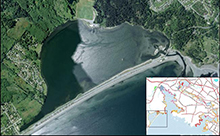 Esquimalt Lagoon is a shallow lagoon enclosed by a sand and gravel barrier spit (Coburg Peninsula), and is connected to the ocean with a tidal channel at the northeast end. The entire lagoon is essentially an estuary, as it receives freshwater from streams and salt water through the tidal channel. Esquimalt Lagoon has the least modified shoreline among the CRD harbours. However, pollution, habitat loss and invasive species are concerns in this area.
Esquimalt Lagoon is a shallow lagoon enclosed by a sand and gravel barrier spit (Coburg Peninsula), and is connected to the ocean with a tidal channel at the northeast end. The entire lagoon is essentially an estuary, as it receives freshwater from streams and salt water through the tidal channel. Esquimalt Lagoon has the least modified shoreline among the CRD harbours. However, pollution, habitat loss and invasive species are concerns in this area.
The unique geological history and physical processes of Esquimalt Lagoon have created an area rich in wildlife. Large numbers of seabirds, shorebirds, and waterfowl can be found here year-round, and it is an important stopover for birds migrating on the Pacific Flyway, a “bird highway” between North and South America. The area is highly valued for wildlife and recreation by locals and visitors to the area. The lagoon is also bordered by some of the oldest coastal Douglas fir forest remaining in the Victoria area.
Historically, the creeks that flow into Esquimalt Lagoon have been degraded by pollution, alteration of the stream flows and channel modification. Still, these creeks remain important fish habitat. Monitoring efforts in Colwood Creek indicate that sea-run cutthroat and coho salmon are found in the creek. Likewise, following recent restoration efforts in Bee Creek, fish monitors have observed sea-run cutthroat, and to a lesser degree, coho salmon.
The Esquimalt Lagoon Stewardship Initiative (ELSI), formed in 2010, is a collaborative group of organizations and governments pursuing a coordinated approach to environmental management and stewardship in the area. The ELSI promotes and supports lagoon stewardship and education, conducts water quality and fish sampling in surrounding creeks and coordinates restoration projects.
About Esquimalt Lagoon
- Size (total area): 90 ha
- Total length of shoreline: 5,013m
- Depth of harbour (average): <3m
- Creeks that flows into the harbour: Colwood Creek, Bee Creek, Selleck Creek
- Number of stormwater discharges: 21
- Protected areas: Esquimalt Lagoon Migratory Bird Sanctuary
- Species at risk: Great blue heron
- History
Valued Habitat
Eelgrass
Eelgrass beds cover a large amount of Esquimalt Lagoon, 19% of the total subtidal area. Eelgrass is a flowering plant with grass-like blades that hosts a complex marine food web. It provides habitat for fish and invertebrates, and food for waterfowl including Brant Geese. Mud flats with eelgrass meadows can provide spawning grounds for herring, which provide food for marine mammals, large fish and sea birds.
Estuary
Esquimalt Lagoon and Witty’s Lagoon are two of the largest estuarine areas in the region. Estuaries are called “nurseries of the sea” for their critical role in provided sheltered habitat and food for juvenile fish such as salmon, sea-run cutthroat trout and herring. These areas also provide many ecosystem services: erosion control and storm surge protection, water quality, atmospheric gas regulation, nutrient cycling, habitat for plants, shorebirds and other animals and education, recreation and tourism opportunities.
Kelp
Large kelp beds cover about six hectares along the bottom of Esquimalt Lagoon. Kelp, principally sugar kelp (Sacharina latissimi), grows in areas of the lagoon that receive the strongest tidal currents, such as at the entrance to the lagoon and in the northeastern portion. Other kelp species present include Alaria sp., Desmarestia sp. and Japanese wireweed (Sargassum muticum).
Salt Marshes
Salt marshes lie at the mouth of Colwood Creek and Bee Creek, as well as a narrow salt marsh fringe borders the western shore of the lagoon itself. Salt marshes are highly productive ecosystems, and provide rich feeding grounds for birds as well as a sheltered environment for fish.
Sand Dunes
Coburg Peninsula Sand dunes are the only coastal sand dunes in the main urban harbours of Greater Victoria. The sand dune system is quite small, less than 2.5 hectares, and has been substantially impacted by human use. However, these dunes do still provide plant and wildlife habitat, a natural barrier against wind and waves, and are worthy of protecting and restoring.
Sand and Gravel Flats
Among the intertidal gravel bars at the entrance to the lagoon, butter clams, littleneck clams, mussels and oysters are quite plentiful. These are likely the largest and most significant intertidal clam beds in the area of Victoria and Esquimalt Harbours. As noted previously, First Nations historically used Esquimalt Lagoon for harvesting shellfish, but today shellfish harvesting is prohibited due to contamination. The sand and gravel flats provide one of the most important migratory bird stop-over areas in the CRD. Migratory birds rely on the bonanza of worms and other invertebrates to gain the fat reserves necessary for long-distance flights.
More information is provided in the Subtidal Survey of the Physical and Biological Features of Esquimalt Lagoon. (PDF)